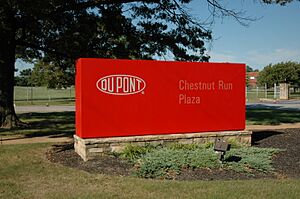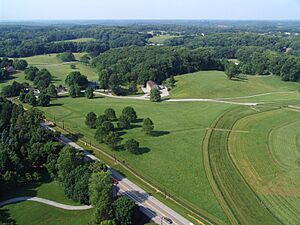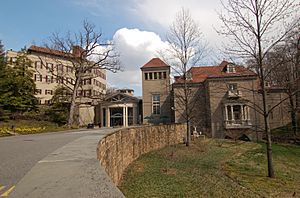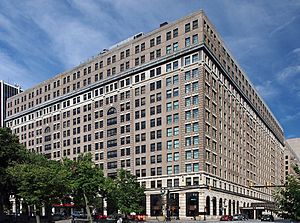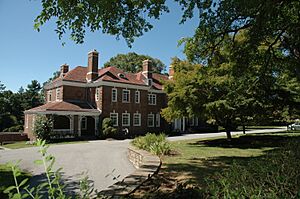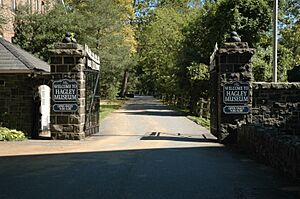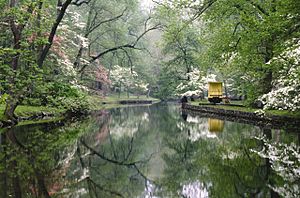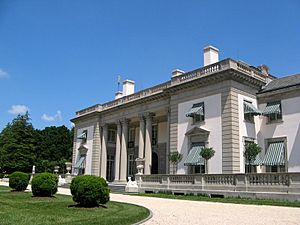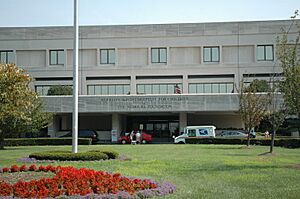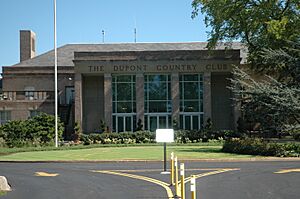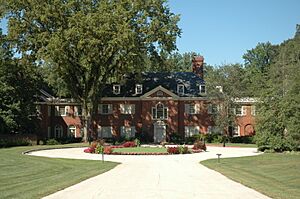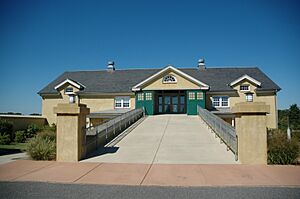List of DuPont historic sites along Delaware Route 141 facts for kids
Along Delaware Route 141, you can find many historic places that tell the story of the Du Pont family and the DuPont company. At one end is DuPont’s Chestnut Run Plaza, and at the other is the Alfred I. duPont Hospital for Children. In between, there are several sites listed on the National Register of Historic Places. These places show the history of American chemical industries, the beautiful homes and gardens of the DuPont family, and their generous giving to the community.
Contents
- Chestnut Run Plaza: A Place for New Ideas
- DuPont Airport: Where Planes Once Landed
- Pelleport: From Home to Health Center
- Delaware Route 52: The Scenic Road
- St. Joseph's on the Brandywine: A Community Church
- Raskob Estate: A Legacy of Giving
- Hagley Museum: Where DuPont Began
- Brandywine Creek: Powering the Past
- DuPont Experimental Station: A Hub of Discovery
- Nemours Mansion and Gardens: A French-Style Estate
- Nemours Children's Hospital, Delaware: Helping Kids Heal
- DuPont Country Club: Sports and Recreation
- Blue Ball Barn: A Modern Dairy Farm
- Images for kids
Chestnut Run Plaza: A Place for New Ideas
DuPont Chestnut Run Plaza is a large research center covering about 240 acres. It is located in Wilmington, Delaware. Building started in 1952. This facility is where scientists work on new technologies and help customers. It has nineteen buildings. Today, DuPont teams here research things like fibers, printing, chemicals for farms, plastics, and even hydrogen fuel cells. Chestnut Run Plaza is also a special place recognized for protecting wildlife.
DuPont Airport: Where Planes Once Landed
The area now called Barley Mill Plaza used to be the DuPont Airport. DuPont owned and ran this private airport from 1924 to 1958. Famous pilot Charles Lindbergh even landed his plane, the "Spirit of St. Louis", there in 1927. Two du Pont family brothers, Richard C. du Pont and Alexis Felix du Pont, Jr., bought a company in 1937 to develop air mail technology at the airport. This company later grew into Allegheny Airlines, which is now known as US Airways.
The airport land was sold and turned into an office park. The DuPont Company rented many offices there and later bought it. It was home to many DuPont business leaders and their legal team. It was sold again and is currently being discussed for new uses. Barley Mill Plaza is also a Certified Wildlife Habitat Council Site.
Pelleport: From Home to Health Center
This place was once the private home of William du Pont. Built in the late 1800s, Pelleport was named after one of the family's old homes in France. It later belonged to his cousin, Eugene du Pont Sr., and his family lived there for two generations. The house was empty for over 25 years. In 1954, it was taken down to build the Eugene du Pont Convalescent Memorial Hospital.
Today, Christiana Care's Eugene du Pont Preventive Medicine & Rehabilitation Institute at Pelleport offers programs to help people stay healthy, prevent sickness, and recover from injuries.
Delaware Route 52: The Scenic Road
Delaware Route 52, also known as Kennett Pike, is a road that connects Wilmington, Delaware to Pennsylvania. It eventually joins U.S. Route 1 near Longwood Gardens. This road was built as a toll road between 1811 and 1813. In 1919, Pierre S. du Pont bought the road and stopped charging tolls. He then paved it, making travel much smoother. People say he paved it so he and his friends could travel easily between his estate at Longwood Gardens and the DuPont headquarters in Wilmington. The state eventually bought the road back. Delaware Routes 52 and 100 together form the beautiful Brandywine Scenic Byway.
Chateau Country: Grand Estates
Route 52 goes through Delaware’s Chateau Country. Many DuPont family homes and large estates are hidden in the areas around Greenville, Delaware and Centreville, Delaware. Local people have worked hard to keep the countryside looking natural by carefully managing new buildings. Twin Lakes Brewing Company in Greenville is located on a farm that once belonged to a DuPont heiress.
Winterthur Museum: A Treasure of America
Between Greenville and Centerville, you'll find the Winterthur Museum, Garden and Library. This museum in Winterthur, Delaware, holds one of the most important collections of early American items in the country. It was once the home of Henry Francis du Pont (1880–1969), who was famous for collecting antiques and for his love of gardening.
The beautiful grounds are open to visitors, and you can take guided tours. The rolling hills are perfect for the yearly Sunday Point-to-Point steeplechase horse races. There are also carriage parades and elegant picnics, making it a special spring event in northern Delaware.
Longwood Gardens: A World of Plants
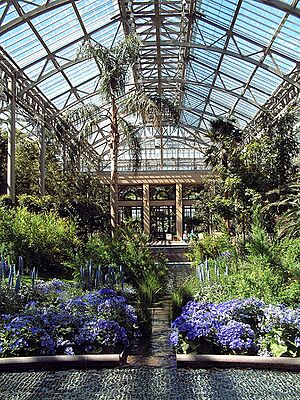
Longwood Gardens is located just past the intersection of Pennsylvania Route 52 and U.S. Route 1. It covers about 1050 acres of gardens, forests, and fields in Kennett Square, Pennsylvania. It is one of the best botanical gardens in the United States.
The land for Longwood Gardens was first bought in 1700 by George Peirce from William Penn. In 1798, Joshua and Samuel Peirce started planting trees for an arboretum. By 1850, they had one of the best tree collections in the nation. Pierre S. du Pont bought the property from the Peirce family in 1906 to save the trees from being cut down for wood. He made it his private estate. From 1906 to the 1930s, du Pont added many things, like the beautiful conservatory with a huge pipe organ and many fountains. Mr. Du Pont opened his estate to the public many days of the year. In 1937, he started the Longwood Foundation. In 1946, the foundation was given the job of running Longwood Gardens for everyone to learn from and enjoy. Besides regular visits, the gardens host many special events, including concerts, fireworks with music, and Christmas lights.
The DuPont Building: A City Landmark
If you head south on Route 52 from Route 141, you will enter Wilmington, Delaware. This city is home to the main offices of the DuPont Company. The most famous DuPont building in Wilmington is The DuPont Building. It takes up a whole city block and was one of the first tall buildings in Wilmington, looking out over Rodney Square. The first part of the building was built in 1908 for DuPont's company offices. In 1913, it was made bigger, adding the DuPont Playhouse and turning part of the original building into the Hotel duPont. The last addition was in 1923. Today, the building still holds DuPont's headquarters, the DuPont Theatre, the Hotel duPont, a bank, and many small shops and offices.
St. Joseph's on the Brandywine: A Community Church
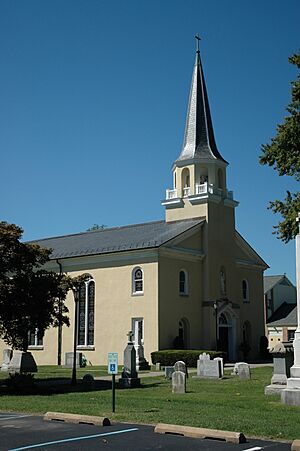
St. Joseph's on the Brandywine Catholic church was built in 1841. DuPont company stonemasons built it during a time when they weren't busy building the DuPont powder works. The land next to the DuPont powder mills was given by Charles I. du Pont. The DuPont company and family also helped pay for most of the building costs.
For eighty years, the church was very connected to the nearby mills. Church members' pew rents were collected by the pastor through deductions from their DuPont Company paychecks. When the mills closed, many people moved away. By the 1930s, it looked like the church might close too. But it was saved when people started moving to the north of Wilmington and to the Greenville, Delaware and Centerville, Delaware areas. This church is the home parish of United States President Joe Biden and several leaders of the DuPont Company.
Raskob Estate: A Legacy of Giving
John J. Raskob started working for Pierre S. du Pont as a personal secretary in 1901. He quickly moved up, becoming treasurer of DuPont in 1914 and vice-president for finance of both DuPont and General Motors in 1918. Raskob was an early investor in General Motors and helped DuPont buy a large part of the company. While at GM, he helped create GMAC, which is now Ally Financial. He also helped build the Empire State Building with Pierre S. du Pont.
Like other DuPont leaders, Raskob was very generous. The Raskob Foundation for Catholic Activities has its offices at "Irisbrook," which was the home of Raskob's younger brother, William F. Raskob. This foundation helps Catholic churches and organizations around the world with religious, charitable, and educational activities. The estate has been divided. Today, it mostly holds facilities for a company that works on advanced technology for science. The beautiful home, Irisbrook, is still there on the southwest side of the estate.
Hagley Museum: Where DuPont Began
The Hagley Museum and Library is located on about 235 acres along the Brandywine Creek. It is known as "where the du Pont story begins." Hagley is the site of the Eleutherian Mills gunpowder factory, started by Eleuthère Irénée du Pont in 1802. It shows what early American industry was like. You can see restored mills, a community where workers lived, and the original home and gardens of the du Pont family.
Brandywine Creek: Powering the Past
The Brandywine Creek flows south through Brandywine Creek State Park and into Wilmington. It then flows through Brandywine Park near the city center. Along its path, it flows past Hagley Museum and Library, where its water powered the early DuPont gunpowder mills. The creek's flow is not huge, but it is steady because it's fed by springs in Pennsylvania. There's a good drop in the river's height near the powder works. Water was redirected by several dams into special channels called mill races. These channels provided enough power to run the powder mills. There are also dams further down the creek that powered other mills in Wilmington, and many of these old water channels are still in good condition.
DuPont Experimental Station: A Hub of Discovery
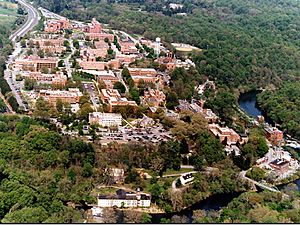
The land right across the Brandywine Creek from Eleutherian Mills was owned by DuPont for safety. No buildings were allowed there because if there was an explosion at the powder mills (and there were some), the blast would be directed towards this strong, heavily wooded hillside. After the mills closed, DuPont built the DuPont Experimental Station here. This was also where the first nine holes of the DuPont Country Club were located, but the golf course moved as the Experimental Station grew.
The DuPont Experimental Station is the largest research and development center for E. I. du Pont de Nemours and Company. It has been the site of many important discoveries in modern chemistry. So, it's not just part of the company's past, but also important for its future. It was started in 1903 to help DuPont move from making gunpowder and explosives into the new world of chemistry. As one of the first industrial research labs in the United States, this 150-acre campus is DuPont's main research facility. It is home to DuPont Central Research and many other DuPont business groups.
The Experimental Station is a Certified Wildlife Habitat Council Site. Besides common birds like pigeons and crows, you can often see eastern cottontail rabbits, white-tailed deer, red-tailed hawks, groundhogs, eastern gray squirrels, and ruby-throated hummingbirds. Red-tailed hawks and red foxes help control animal populations, and nearby turkey vultures help keep the grounds clean.
Nemours Mansion and Gardens: A French-Style Estate
The Nemours Mansion and Gardens is a beautiful 300-acre country estate with formal French-style gardens and a classical French mansion. This grand property is hidden behind a stone fence.
The mansion looks like a French Château and has more than seventy rooms spread over five floors, covering almost 47,000 square feet. The estate is owned by the Nemours Foundation. Alfred I. du Pont created Nemours in 1909–1910. He named it after a French town connected to his great-great-grandfather, Pierre Samuel du Pont de Nemours. The home was designed in the style of Louis XVI—a Rococo French architecture style. You can take guided tours, but it's a good idea to make reservations, especially for groups.
Nemours Children's Hospital, Delaware: Helping Kids Heal
Nemours Children's Hospital, Delaware is a special hospital for children located in Wilmington, Delaware. It is run by the Nemours Foundation, a non-profit group started by Alfred I. du Pont in 1936. He believed everyone should help reduce human suffering. He gave $40 million to create a charity focused on providing healthcare for children. The Nemours Foundation was tasked with caring for disabled children and low-income seniors throughout Delaware. Nemours has grown to be one of the largest children’s health systems in the country, helping over a quarter of a million children each year.
DuPont Country Club: Sports and Recreation
The DuPont Country Club is a place for sports and fun that was once owned and run by the DuPont Company. It started in 1920 with 600 members. The first "clubhouse" was a two-story house with a baseball field. The first DuPont golf course, with 9 holes, was designed in 1921. This original course was later replaced by the growing DuPont Experimental Station. Two new courses and a clubhouse were then built at their current location. The old clubhouse became a cafeteria for Experimental Station employees, and the original pro-shop became the home of the DuPont employees' credit union. From 1994 to 2004, it hosted the LPGA Championship, a major women's golf tournament. In 2018, a company called Rockland Sports, LLC bought the club.
Brantwyn: A Historic Home
The DuPont Country Club also includes the DuPont estate called Brantwyn. This was the childhood home of Pierre S. du Pont, IV. The name "Brantwyn" likely comes from the name Brandywine. The creek's name might come from an old Dutch word for brandy or gin, "brandewijn," or from an early mill owner named Andreas Brainwende or Brantwyn.
Blue Ball Barn: A Modern Dairy Farm
Just off the main map is an amazing dairy barn, built in 1914 by Alfred I. DuPont to serve Nemours. Next to it is a milk-house with glass tiles. This facility was designed to be the most modern dairy barn in the United States at the time. The upper floor of the barn stored food for the cows. The lower level was where cows were milked and calves were born. Cows waiting to be milked were kept in a courtyard with stucco walls.
It is named after the Blue Ball Tavern, an old inn and meeting place that used to be nearby. A blue ball on a pole in front of the tavern signaled stagecoach drivers to stop and pick up passengers, which is how it got its name. The restored Blue Ball Barn is now the main feature of the new Alapocas Run State Park. The Blue Ball Barn is the permanent home for the Delaware Folk Art Collection, and it also has an exhibit about the barn's history.
Images for kids
-
Building E400 on the DuPont Experimental Station with Canada geese who are frequent visitors.
-
Main Fountains at Longwood Gardens
-
Indoor Conservatory at Longwood Gardens
-
The main fountains at Longwood Gardens
-
Restored Gunpowder Mill at Hagley Museum and Library
-
Mill Race at Hagley Museum and Library
-
Restored Mill Equipment at Hagley Museum and Library
-
Unrestored Gunpowder Mill at Hagley Museum and Library


